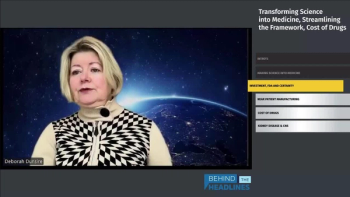
Cell and Gene Therapy Production Facilities
In this episode of the Ask the Expert video series, Peter Walters, Fellow of Advanced Therapies at CRB Group, discusses factors to be considered in constructing a new facility for cell and gene therapy production as well as using an existing facility to expand cell and gene therapy pipelines.
Once a therapy has been discovered and proven, it has to be manufactured in order to reach patients. However, depending on the therapeutic modality, companies can be left with a difficult decision of whether or not their existing facilities will meet their manufacturing needs or whether they need a new facility entirely. Cell and gene therapies come with unique challenges that must be considered when either building a new manufacturing facility or expanding an existing one. Peter Walters, Fellow of Advanced Therapies at CRB Group, gives his insight on some of the challenges and benefits of creating new production facilities and/or expanding on what is already available.
To ensure one follows current good manufacturing practices when building a new facility for the production of cell and gene therapies, Walters stresses that one should understand the requirements by reading the European Medicines Agency (EMA) or the Pharmaceutical Inspection Co-operation Scheme (PIC/S) guidelines. “[T]hose, I think, are the most prescriptive in terms of what is expected and what is possible to do with your facility and your equipment, and the kinds of classifications [and] handling requirements required,” says Walters. “I think it's important to brush up on those, because cell therap[ies] especially have requirements that are a bit nuanced and different than a lot of other biotech—a lot going to chain of custody, a lot going to the degree of segregation that has to happen, the degree of quality control that has to happen, especially with open operations. A lot of these therapies can't be sterilized just prior to filling, and so they have to be handled with extreme care throughout the entire lifespan of their production, and so, … understanding those requirements is going to be crucial [to make] sure you've got a facility and an equipment plan and a development plan that's going to get you the whole way through to commercial.”
When it comes to using a current facility to expand a cell or gene therapy pipeline, Walters says, “I think we've seen a number of companies successfully, effectively, more or less bolt on a production facility onto their existing building, or build a small [campus], [such as] create a small building that has a spine that connects it, or something like that.
And so that way you're not really disrupting your ongoing production, but you gain the access to that office space. You gain access to the labs and the warehousing and all of that sort of shared, common support space that maybe can be leveraged across both [and] utility systems can sometimes be split between the two. [T]hat way, you can create a new production that doesn't have to come with the cost of a whole new mechanical infrastructure, and especially if we're talking about cell therapy, typically, those types of facilities have a larger air handling load sometimes, but they can be smaller clean rooms. And so, the overall load could be small, and then the rest of the utility load might be very, very low.”
Click the video above to watch Peter answer the following questions:
- My company is planning new construction of a cell and gene therapy production facility. How can we ensure it meetings CGMP requirements?
- How can we use our current facility to expand our cell and gene therapy pipeline?
This episode’s expert
Peter Walters is Fellow of Advanced Therapies at CRB Group.
Ask the Expert Video Series
Welcome to the Ask the Expert video series. This series is an extension of the PharmTech Group’s long-running print column in which industry experts answer common quality and regulatory questions from the industry. This new video series will expand on topic areas to include development and manufacturing concerns to help those working in the industry better understand bio/pharmaceutical requirements. Have a question you would like answered? Send it to
We hope you enjoy the discussion!
Newsletter
Get the essential updates shaping the future of pharma manufacturing and compliance—subscribe today to Pharmaceutical Technology and never miss a breakthrough.




